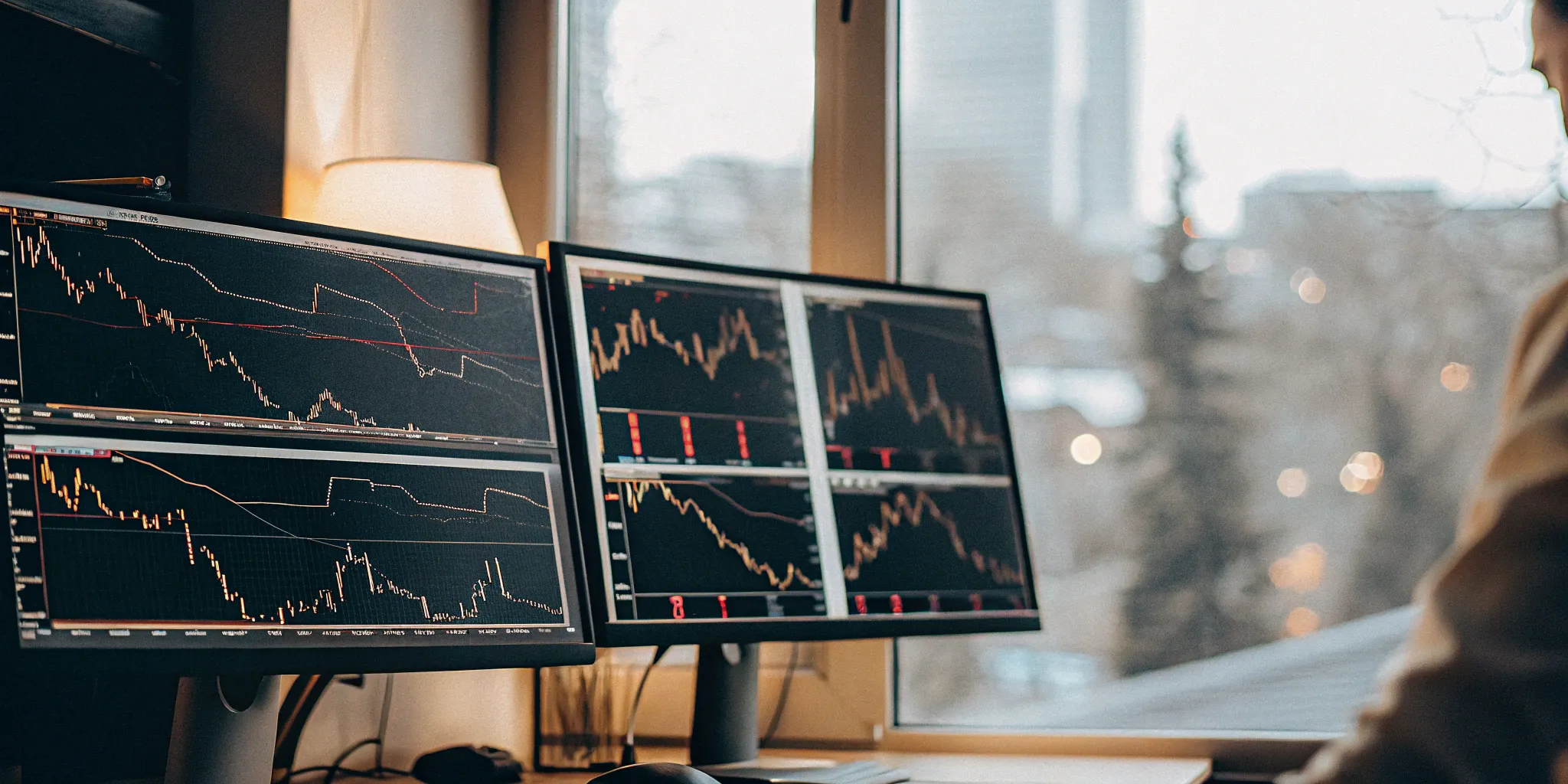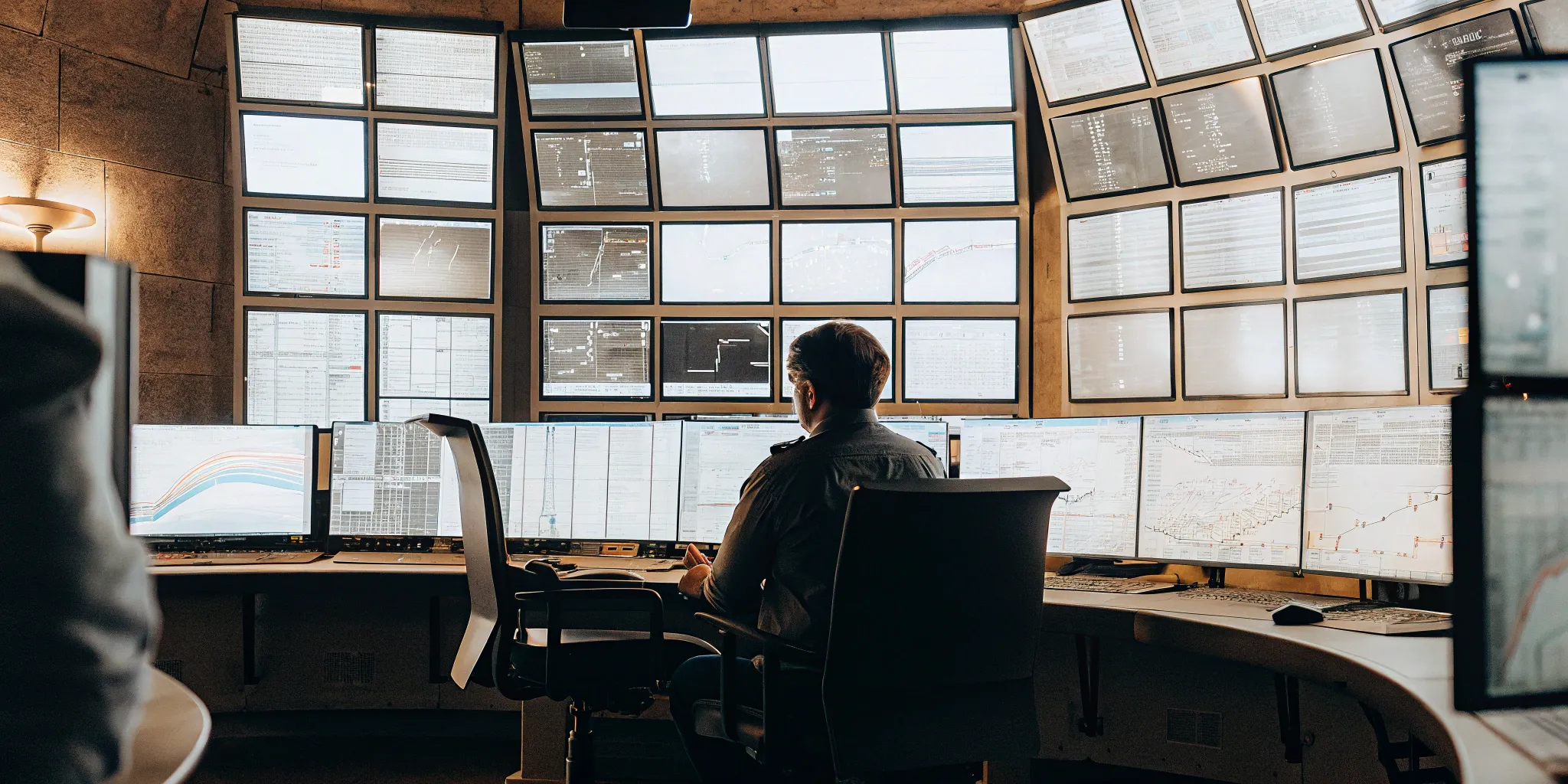Ready to take your trading to the next level? Algorithmic trading is no longer a futuristic concept—it’s here, and it’s changing the game. Staying ahead of the curve means understanding the key algo trading trends 2025, and this comprehensive guide is your roadmap to success. We’ll explore the core principles of algo trading, from its basic components to the latest advancements in AI and machine learning. Whether you’re a seasoned trader or just starting, this article will provide you with the knowledge and tools you need to navigate this exciting landscape. We’ll cover everything from developing robust trading strategies to managing risk effectively, ensuring you’re equipped to make informed decisions in today’s rapidly evolving markets.
Key Takeaways
- AI-powered trading is here to stay: From predictive analytics to automated strategy development, AI is revolutionizing how we trade, offering significant advantages in speed, efficiency, and adaptability.
- Regulations are catching up: Increased transparency and robust risk management are key focuses for regulators as they work to establish a secure and fair environment for algorithmic trading, impacting everyone from retail investors to institutional players.
- Continuous learning is essential: To succeed in the evolving world of algo trading, focus on developing a strong understanding of market dynamics, data analysis, and risk management, while exploring and mastering emerging technologies like AI and blockchain.
What is Algorithmic Trading?
What is Algorithmic Trading?
Algorithmic trading (algo trading) uses computer programs and algorithms to execute trades automatically. This automated approach aims to capitalize on market opportunities at speeds and frequencies impossible for human traders. Algo trading has become incredibly popular, especially among US traders, where it now dominates the market. It removes human bias, optimizing real-time market execution through data-driven intelligence. At FN Capital, our proprietary FAST AI algorithm executes thousands of trades per month, primarily focusing on EUR/USD to ensure optimized liquidity management and execution precision. Our live performance is publicly verifiable, giving you full transparency into our consistent track record.

Key Components of Algo Trading Systems
The backbone of any effective algo trading system is its regulatory framework, especially concerning API-based algo trading. Recent regulations focus on API use, algorithm registration, and sharing third-party strategies. These rules aim to create more transparency and accountability in algo trading, impacting retail traders, algo providers, and brokers. FN Capital operates within a structured legal framework, using Third Party Fund Administrators (TPFAs) to allow clients seamless access to international brokers. This ensures we maintain compliance and offer a secure trading environment.
The Evolution of Algo Trading
Algorithmic trading is booming, currently representing about 70% of trading volume in US markets. This growth isn’t limited to the US; emerging markets like India also see a significant rise, with algorithms driving roughly 40% of their trading volume. This global expansion of algo trading signals a major shift in how trading operates, with technology taking center stage. FN Capital is at the forefront of this evolution, offering a 100-day money-back guarantee so you can confidently explore the potential of AI-driven trading. Learn more about how our AI-powered solutions can work for you.
AI and Machine Learning Integration
Algorithms are becoming increasingly sophisticated. We’re moving beyond static rule-based systems to dynamic, self-learning models. Future algorithms will use machine learning to adapt to shifting market conditions and process information from multiple data sources, essentially learning and improving over time. This adaptability is crucial for staying profitable in ever-changing markets. At FN Capital, our FAST AI algorithm exemplifies this trend, constantly refining its strategies based on real-time market data.
Big Data Analytics and Real-Time Processing
The sheer volume of available data today presents both a challenge and an opportunity. Big data analytics, including augmented analytics that combine AI and human expertise, allows for more accurate market predictions. Coupled with real-time processing, these insights can be acted upon instantaneously, giving traders an edge. This data-driven approach is becoming increasingly critical for successful algorithmic trading. FN Capital leverages these advancements to ensure our clients benefit from the most up-to-date market analysis.
Cloud Computing and Distributed Systems
Cloud computing offers the scalability and flexibility needed for high-frequency trading (HFT). Distributed systems allow for faster processing and greater resilience, essential for handling the demands of complex algorithms and vast datasets. This infrastructure is becoming increasingly important, especially for those operating in the fast-paced world of HFT. The robust infrastructure at FN Capital ensures our AI can operate efficiently and effectively.
High-Frequency Trading Advancements
High-frequency trading (HFT) involves executing a large number of trades at incredibly high speeds. While potential regulations are on the horizon, HFT is likely to remain a dominant force in algorithmic trading. Advancements in technology and infrastructure continue to push the boundaries of speed and efficiency, making HFT a key area to watch. FN Capital is committed to staying at the forefront of these advancements to deliver optimal results for our clients.
How AI Transforms Algorithmic Trading Strategies
AI is rapidly changing how algorithmic trading strategies are developed and executed. It’s not just about speed anymore; it’s about intelligence, adaptability, and precision. Let’s explore some key ways AI is revolutionizing the game.
Enhanced Predictive Analytics
Forget static algorithms. AI empowers trading systems to analyze massive datasets, identify complex patterns, and generate more accurate market predictions. Instead of relying on historical data alone, AI can incorporate real-time news sentiment, social media trends, and other alternative data sources to anticipate market movements. This predictive capability gives traders a significant edge in making informed decisions. AI and machine learning allow algorithms to adapt to changing market conditions and continuously learn and improve over time. This allows traders to better anticipate market shifts and capitalize on emerging opportunities.
Adaptive Learning Algorithms
AI-powered algorithms aren’t fixed; they evolve. Through machine learning, these algorithms can adapt to changing market conditions in real time. They learn from past trades, identify successful patterns, and adjust their strategies accordingly. This continuous learning process allows algorithms to optimize their performance and stay ahead of the curve, even in volatile markets. High-Frequency Trading (HFT), involving extremely fast, high-volume transactions, will likely become even more common. AI’s adaptability is crucial for navigating the complexities of today’s fast-moving markets.
How AI Transforms Algorithmic Trading Strategies
AI is rapidly changing how algorithmic trading strategies are developed and executed. It’s not just about speed anymore; it’s about intelligence, adaptability, and precision. Let’s explore some key ways AI is revolutionizing the game.
Enhanced Predictive Analytics
Forget static algorithms. AI empowers trading systems to analyze massive datasets, identify complex patterns, and generate more accurate market predictions. Instead of relying on historical data alone, AI can incorporate real-time news sentiment, social media trends, and other alternative data sources to anticipate market movements. This predictive capability gives traders a significant edge in making informed decisions. AI and machine learning allow algorithms to adapt to changing market conditions and continuously learn and improve over time. This allows traders to better anticipate market shifts and capitalize on emerging opportunities.
Adaptive Learning Algorithms
AI-powered algorithms aren’t fixed; they evolve. Through machine learning, these algorithms can adapt to changing market conditions in real time. They learn from past trades, identify successful patterns, and adjust their strategies accordingly. This continuous learning process allows algorithms to optimize their performance and stay ahead of the curve, even in volatile markets. High-Frequency Trading (HFT), involving extremely fast, high-volume transactions, will likely become even more common. AI’s adaptability is crucial for navigating the complexities of today’s fast-moving markets.
Automated Strategy Development
Developing a robust trading strategy requires extensive research, backtesting, and refinement. AI streamlines this process by automating key aspects of strategy development. AI-driven tools can analyze historical data, identify profitable trading signals, and even generate new trading strategies from scratch. This automation frees up traders to focus on higher-level tasks, such as risk management and portfolio optimization. This allows for faster development and deployment of sophisticated trading strategies. AI is transforming how traders approach strategy creation, making it more efficient and data-driven.
Advanced Risk Management
While AI enhances profit potential, it also plays a crucial role in mitigating risk. AI-powered risk management systems can monitor market conditions in real time, identify potential threats, and automatically adjust trading parameters to minimize losses. These systems can dynamically adjust position sizes, set stop-loss orders, and even halt trading altogether if necessary. Remember, successful algo trading requires more than just software; it needs careful planning, data accuracy, and ongoing human oversight. AI provides powerful tools, but human expertise remains essential for effective risk management. This combination of AI and human intelligence creates a robust framework for navigating market uncertainties.
Adoption of Advanced Technologies
While regulators are cautious about the potential risks of advanced technologies in algo trading, they also recognize the benefits. Regulators are encouraging the adoption of technologies that enhance market surveillance and risk detection. SEBI’s framework, for example, is seen as a step forward in enabling automation while ensuring responsible trading practices. This includes AI-powered tools for detecting anomalies and patterns indicative of market abuse. Furthermore, regulators are exploring the use of blockchain technology to improve transparency and auditability in algo trading. This could involve recording trades on a distributed ledger, making it easier to track and verify transactions.
Potential Risks and Challenges in Algo Trading
While algorithmic trading presents exciting opportunities, it’s important to also understand the potential downsides. Like any investment strategy, algo trading has inherent risks and challenges that you need to consider. Let’s explore some key areas to be aware of:
Technical Failures and System Vulnerabilities
Technical glitches can disrupt trading operations, leading to unintended consequences. System failures, whether in your hardware, software, or network infrastructure, can cause delays or even prevent orders from executing as planned. A robust and reliable backup system is essential to mitigate these risks and ensure business continuity. Regularly testing and maintaining your systems is also critical to identify and address vulnerabilities.
Market Volatility and Flash Crashes
Market volatility, with its rapid and unpredictable price swings, can create significant challenges for algo trading systems. High-frequency trading (HFT), while offering speed and efficiency, can exacerbate market volatility during stressful periods. Flash crashes—sudden, dramatic drops in asset prices—can trigger automated sell-offs and substantial losses if not managed effectively. Robust risk management protocols and safeguards are crucial for navigating these volatile market conditions.
Cybersecurity Concerns
As algo trading systems become more sophisticated and interconnected, they also become more vulnerable to cybersecurity threats. Malicious actors can exploit vulnerabilities to gain unauthorized access, manipulate trading algorithms, or steal sensitive data. Protecting your systems with strong security measures, including firewalls, intrusion detection systems, and regular security audits, is paramount.
Data Quality and Integrity Issues
The effectiveness of algo trading strategies depends heavily on the quality and integrity of the data they use. Inaccurate or incomplete data can lead to flawed trading decisions and poor performance. Ensuring data accuracy through rigorous validation processes and using reliable data sources is essential. Maintaining data integrity by protecting against data corruption and unauthorized changes is also crucial for building trust and confidence in your trading system. Remember, successful algo trading requires more than just sophisticated software; it requires careful planning, reliable data, and human oversight.
Emerging Opportunities in Algorithmic Trading
Algorithmic trading continues to evolve, creating exciting new opportunities for both seasoned professionals and newcomers. Let’s explore some key areas ripe for growth:
Retail Investor Participation
Algorithmic trading is no longer exclusive to institutional players. Changes in regulations are opening doors for retail investors to leverage automated trading. For example, India’s market regulator, SEBI, announced a new framework to broaden retail investor access to algo trading, starting August 2025. This shift empowers individual investors with sophisticated tools previously unavailable to them, allowing them to benefit from the speed, precision, and emotionless decision-making of automated systems.
Potential Risks and Challenges in Algo Trading
While algorithmic trading presents exciting opportunities, it’s important to also understand the potential downsides. Like any investment strategy, algo trading has inherent risks and challenges that you need to consider. Let’s explore some key areas to be aware of:
Technical Failures and System Vulnerabilities
Technical glitches can disrupt trading operations, leading to unintended consequences. System failures, whether in your hardware, software, or network infrastructure, can cause delays or even prevent orders from executing as planned. A robust and reliable backup system is essential to mitigate these risks and ensure business continuity. Regularly testing and maintaining your systems is also critical to identify and address vulnerabilities.
Market Volatility and Flash Crashes
Market volatility, with its rapid and unpredictable price swings, can create significant challenges for algo trading systems. High-frequency trading (HFT), while offering speed and efficiency, can exacerbate market volatility during stressful periods. Flash crashes—sudden, dramatic drops in asset prices—can trigger automated sell-offs and substantial losses if not managed effectively. Robust risk management protocols and safeguards are crucial for navigating these volatile market conditions.
Cybersecurity Concerns
As algo trading systems become more sophisticated and interconnected, they also become more vulnerable to cybersecurity threats. Malicious actors can exploit vulnerabilities to gain unauthorized access, manipulate trading algorithms, or steal sensitive data. Protecting your systems with strong security measures, including firewalls, intrusion detection systems, and regular security audits, is paramount.
Data Quality and Integrity Issues
The effectiveness of algo trading strategies depends heavily on the quality and integrity of the data they use. Inaccurate or incomplete data can lead to flawed trading decisions and poor performance. Ensuring data accuracy through rigorous validation processes and using reliable data sources is essential. Maintaining data integrity by protecting against data corruption and unauthorized changes is also crucial for building trust and confidence in your trading system. Remember, successful algo trading requires more than just sophisticated software; it requires careful planning, reliable data, and human oversight.
Emerging Opportunities in Algorithmic Trading
Algorithmic trading continues to evolve, creating exciting new opportunities for both seasoned professionals and newcomers. Let’s explore some key areas ripe for growth:
Retail Investor Participation
Algorithmic trading is no longer exclusive to institutional players. Changes in regulations are opening doors for retail investors to leverage automated trading. For example, India’s market regulator, SEBI, announced a new framework to broaden retail investor access to algo trading, starting August 2025. This shift empowers individual investors with sophisticated tools previously unavailable to them, allowing them to benefit from the speed, precision, and emotionless decision-making of automated systems.
New Asset Classes and Markets
The expansion of algorithmic trading isn’t limited to just who can participate—it’s also about what can be traded. We’re seeing new asset classes and markets become accessible through algorithmic strategies, including everything from cryptocurrencies and digital assets to emerging markets and niche investment opportunities. As technology advances, the possibilities for automated trading across diverse asset classes continue to expand. This, coupled with updated regulations from bodies like SEBI in India, creates a more transparent and secure environment for exploring these new markets.
Cross-Asset Correlation Strategies
As algorithmic trading matures, more sophisticated strategies are emerging. One key area is cross-asset correlation strategies, which leverage the relationships between different asset classes to identify and capitalize on market inefficiencies. By analyzing vast amounts of data and using advanced algorithms, traders can develop strategies that take advantage of correlations between, for example, stocks, bonds, commodities, and currencies. This approach allows for more diversified and potentially less volatile portfolios. SEBI’s circular on algo trading, particularly those impacting API-based trading, further supports the development and implementation of these complex strategies.
The Impact of Algo Trading on Global Financial Markets
Algorithmic trading has reshaped financial markets, influencing everything from liquidity to how we integrate emerging technologies. Let’s explore some key impacts:
Market Efficiency and Liquidity
Algo trading, now dominant in markets like the US, accounting for roughly 70% of trading volume, significantly impacts market efficiency and liquidity. This automated approach executes trades at incredible speeds, minimizing price discrepancies and enhancing price discovery. The result? More stable markets with tighter spreads and readily available buyers and sellers. However, this shift also creates a fiercely competitive landscape, with regulations playing a crucial role in market development. Emerging markets are also seeing rapid growth in algo trading, with regions like India already attributing around 40% of their trading activity to algorithms.
Integrating Blockchain and DeFi
The convergence of algo trading with blockchain technology and decentralized finance (DeFi) presents exciting opportunities. Governments worldwide are increasingly supporting blockchain and digital assets, fostering a supportive environment for algorithmic trading innovation. This integration can lead to greater transparency, reduced counterparty risk, and faster settlement times. Furthermore, the combination of AI, high-frequency trading, and blockchain is fundamentally changing how trades are executed, paving the way for more efficient and accessible markets.
Focus on ESG Factors in Trading Algorithms
As algorithms become more sophisticated, integrating environmental, social, and governance (ESG) factors is gaining traction. Investors need a clear understanding of how these algorithms incorporate ESG considerations into trading strategies. This shift reflects a growing demand for socially responsible investing, where financial returns are balanced with ethical and sustainable practices. For companies to remain competitive, investing in AI, machine learning, and cloud-based solutions is essential, including adapting to the increasing focus on ESG-compliant trading.
Regulation plays a vital role in maintaining market integrity and protecting investors. Regulatory bodies are increasingly focused on transparency and accountability in algo trading, implementing rules around algorithm registration, API usage, and risk management practices. Staying informed about these regulations is crucial for anyone involved in algo trading.
What are some key trends shaping the future of algorithmic trading?
Several exciting trends are shaping the future. The integration of AI and machine learning is leading to more sophisticated and adaptive algorithms. Big data analytics and real-time processing provide deeper market insights. Cloud computing offers the scalability and flexibility needed for high-frequency trading. The convergence of algo trading with blockchain and DeFi presents opportunities for greater transparency and efficiency. Finally, the increasing focus on ESG factors reflects a growing demand for socially responsible investing.
Frequently Asked Questions
Is algorithmic trading only for professional traders?
Not anymore. While algo trading was once the domain of large institutions, it’s becoming increasingly accessible to everyday investors. New regulations and user-friendly platforms are opening doors for individuals to leverage the power of automated trading. At FN Capital, we welcome everyone, from beginners to seasoned pros, to explore the benefits of our AI-powered trading system.
What are the main advantages of using AI in algorithmic trading?
AI brings several key advantages. It allows for more sophisticated predictive analytics, using vast datasets and machine learning to forecast market movements. AI-powered algorithms can adapt to changing conditions in real time, constantly learning and refining their strategies. AI also automates key aspects of strategy development and enhances risk management by monitoring markets and adjusting trading parameters to minimize potential losses.
How can I mitigate the risks associated with algorithmic trading?
Managing risk effectively is crucial in algo trading. Start by diversifying your strategies and not putting all your eggs in one basket. Thoroughly backtest any algorithm before deploying it with real capital to understand its potential behavior in different market scenarios. Implement robust risk management rules, including stop-loss orders and position sizing limits, to control potential losses. Finally, stay informed about regulatory changes and ensure your trading practices comply with all applicable rules.
What is the role of regulation in algorithmic trading?
Regulation plays a vital role in maintaining market integrity and protecting investors. Regulatory bodies are increasingly focused on transparency and accountability in algo trading, implementing rules around algorithm registration, API usage, and risk management practices. Staying informed about these regulations is crucial for anyone involved in algo trading.
What are some key trends shaping the future of algorithmic trading?
Several exciting trends are shaping the future. The integration of AI and machine learning is leading to more sophisticated and adaptive algorithms. Big data analytics and real-time processing provide deeper market insights. Cloud computing offers the scalability and flexibility needed for high-frequency trading. The convergence of algo trading with blockchain and DeFi presents opportunities for greater transparency and efficiency. Finally, the increasing focus on ESG factors reflects a growing demand for socially responsible investing.





